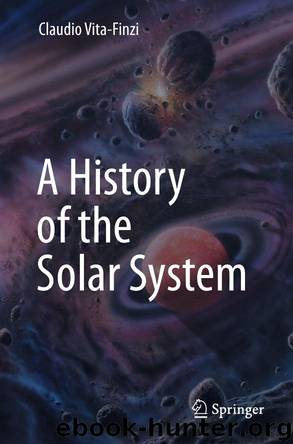A History of the Solar System1 by Claudio Vita-Finzi

Author:Claudio Vita-Finzi
Language: eng
Format: epub
Tags: gnv64
Published: 2016-07-11T16:00:00+00:00
52
5
Differentiation
Fig. 5.3 Vesta, the largest asteroid in the Solar System (mean diameter 525 km) and the secondmost massive body in the asteroid belt after the dwarf planet Ceres. It was orbited by NASA’sspacecraft Dawn in 2011 and 2012. Image shows varied composition indicating differentiation con-sistent with its status as a protoplanet. Courtesy of NASA/JPL-CALTECH/UCLA/MPS/IDA/PSI
A common source of internal heating, the radioactive decay of the isotopesaluminium-26 and iron-60 ( 26 Al and 60 Fe, half-lives 7.3 × 10 5 yr and 2.62 × 10 6 yr respectively), imposes a limit on the autonomous activity of the accreted bodywhich hinges largely on its content of the two isotopes and therefore its volume.For the Moon and Mercury this amounts to about 10 9 years [ 11 ] after which themagmatic activity that can be discerned on their surfaces came to an end. Thesedead planets, like their active companions, will of course continue to receive theenergy of impacts, which may lead to localised melting from the impact to thepoint where major episodes of crustal displacement result [ 33 ].Planetary crusts come in many varieties and dimensions, as do cores and thesolid and liquid mantles that encircle them. Their definition may be thermal,chemical, dynamic or some combination of attributes. The Sun’s outer zones arethus generally defined by the mode of heat transfer (radiative, convective) and theEarth’s vary according to the application of the analysis (seismic, tectonic, pet-rological). The presence of subsurface oceans, of great interest in the search forextraterrestrial life, may be inferred from gravitational data derived from space-craft behaviour, from the escape of geysers or from distinctive surface features.The question remains how much a body’s differentiation is primarily or whollyowed to gravity (and thus density) acting benignly over time and how much toimpact. Collision between embryos and planetesimals liberates high energies andmay lead to the formation of a magma ocean [ 34 ]. If it is correct to assume that latestages of planetary accretion witness few, large collisions, these may well include hit-and-run-events, ‘perfect mergers’, and smashes [ 10 ] which retain two altered bodies.In magma oceans that form at the surface there takes place segregation betweensilicates and metals leading, at least in the terrestrial planets and probably in
Download
This site does not store any files on its server. We only index and link to content provided by other sites. Please contact the content providers to delete copyright contents if any and email us, we'll remove relevant links or contents immediately.
Man-made Catastrophes and Risk Information Concealment by Dmitry Chernov & Didier Sornette(5951)
The Revenge of Geography: What the Map Tells Us About Coming Conflicts and the Battle Against Fate by Kaplan Robert D(4052)
Zero Waste Home by Bea Johnson(3804)
COSMOS by Carl Sagan(3584)
Good by S. Walden(3516)
In a Sunburned Country by Bill Bryson(3506)
The Fate of Rome: Climate, Disease, and the End of an Empire (The Princeton History of the Ancient World) by Kyle Harper(3030)
A Wilder Time by William E. Glassley(2833)
Camino Island by John Grisham(2778)
Organic Mushroom Farming and Mycoremediation by Tradd Cotter(2660)
The Ogre by Doug Scott(2657)
Human Dynamics Research in Smart and Connected Communities by Shih-Lung Shaw & Daniel Sui(2479)
Energy Myths and Realities by Vaclav Smil(2461)
The Traveler's Gift by Andy Andrews(2433)
9781803241661-PYTHON FOR ARCGIS PRO by Unknown(2341)
Inside the Middle East by Avi Melamed(2325)
Birds of New Guinea by Pratt Thane K.; Beehler Bruce M.; Anderton John C(2235)
A History of Warfare by John Keegan(2210)
And the Band Played On by Randy Shilts(2163)
